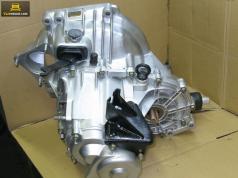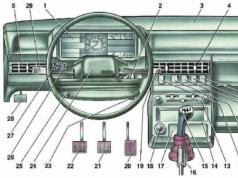I think no one will argue that any gearbox is one of the most key parts in a car. Therefore, all problems that sooner or later arise with the checkpoint must be eliminated in time. After all, this is a rather serious mechanism, the repair of which, in certain situations, can be very expensive and comparable even to repairing an engine.
Mechanical transmission sectional view
During operation, the box can demonstrate various troubles that stand out not only for the characteristic soundtrack. But, in today's example, let's take the hum as a basis, what kind of malfunctions can it indicate and what consequences can the owner of the car expect?
Interestingly, the howl can be completely different, differ from the traffic intensity, speed, gear engaged, and the like, but his symptoms usually boil down to one list of problems.
By the way, it may not always indicate that there are problems with the checkpoint. It is quite realistic that this is a design feature of a particular mechanism or the device has just been repaired, that is, the parts have not yet got used to it. In addition, the reason for the appearance of noise can be not only the gearbox itself, but also the units associated with it, for example, the clutch, if we are talking about "mechanics". The spring is loose, the release bearing is worn out, etc.
Hum on the "mechanics"
The mechanical box is widespread, structurally not having a very complex system, however, there are enough reasons why noise can be heard.
 What the manual transmission consists of
What the manual transmission consists of
For example, the position of the box in neutral, with the clutch depressed, a howl is heard, the reason for this, in most cases, is a worn input shaft bearing or a drive gear bearing. It's the same when you release the clutch and you hear a noise, it's all about the input shaft bearing.
 In the photo: the remnants of the bearing in the input shaft. Photo - drive2.ru
In the photo: the remnants of the bearing in the input shaft. Photo - drive2.ru
In general, there can be many reasons for causing extraneous sounds, even for "mechanics":
Wear of the main elements of the main pair (shaft, gear).
 In the photo: gear wheel of manual transmission GAZ 21
In the photo: gear wheel of manual transmission GAZ 21
Worn bearings of shafts, gears. In this mode, they can work even for several months, but after such neglect, it will result in expensive repairs.
Problems with individual gears (teeth worn out or crumbled), for example, if a howl is heard only when a certain gear is engaged.
Oil starvation. Few people pay attention to the oil level in the box, but this is an important indicator. If the oil falls below the mark, a sound will be heard in certain gears.
 Checking the oil in the manual transmission Hyundai i30
Checking the oil in the manual transmission Hyundai i30
Often, the fifth gear, which is the highest, suffers from an insufficient amount of lubricant.
The oil is too thick. With a high degree of viscosity, the oil creates, like a protective film on the parts, making it difficult for the lubricant to access certain parts. By the way, one of the signs that too thick oil is used is the presence of a hum on "cold", after warming up, which disappears.
The oil is of poor quality and needs to be replaced. Waste oil, possibly contaminated with metal particles and water.
 Chips on the magnet of the gearbox drain plug
Chips on the magnet of the gearbox drain plug
Worn synchronizers or locking rings on the shaft.
 In the photo: the locking ring of the synchronizer
In the photo: the locking ring of the synchronizer
Problems with the "fork" of the checkpoint. At the same time, it is not uncommon for a "" transmission.
By the way, if you hear noise during gear shifting, then you should pay attention first of all to the clutch, possibly problems with. Precisely the problems with the release will be indicated by the fact that when squeezing, that is, when you press on, a rustle is heard. But if, on the contrary, when you release the pedal and you hear a noise, then almost certainly problems with the box itself.

Also, the wear of the clutch will be indicated by the fact that the gears are not engaged accurately or with a noticeable noise, crunch, this is especially evident in the first and second gear.
In addition, the reason may lie in the synchronizers. Check the wear of the synchronizer parts, blocking rings, and measure the gap between the gear and the blocking ring. In different models of the box, the data may differ, read the manual.
The hum of an automatic transmission, robot or variator
The structural part of such boxes is much more technologically advanced, therefore much more attention is paid to problems with them. It is often difficult to identify a malfunction without disassembling the assembly completely; even specialists cannot really determine the problems using computer diagnostics. As a rule, a complete or partial disassembly of the node is required, with live diagnostics. It seems that many motorists try not to pay attention to the howl, which in the end still results in expensive repairs. Here are just a small part of the reasons why a buzz may occur at the checkpoint data:
The main shaft pair has worn out in the same way.
Poor fastening of the axle shafts, which may cause even a slight backlash.
Excessive friction of parts, in particular gears due to misalignment during installation or after repair.
The bearings of the shaft and gears are out of order.
Worn gears, worn out teeth, wear on the shaft, all this leads to the appearance of various sounds.
The level of the liquid and its quality do not correspond to the regulated norms of the manufacturer.
 In the photo: automatic transmission without a pallet, dismantling the oil filter
In the photo: automatic transmission without a pallet, dismantling the oil filter
What if there is a rumble?
In any case, from the listed reasons, it is clear that the problems can be quite serious and lead to expensive repairs, so you should not neglect such a "signal". You will need the help of a specialist, you cannot get away from this, because, as a person who is not familiar with the mechanism, it is difficult to independently determine the problem with one hundred percent accuracy.
I would like to give some important advice during the checkpoint diagnostics:
1. Find out what exactly caused the howling, if this is the shaft of the main pair, then keep in mind that it has already influenced other parts of the mechanism. Therefore, it is likely that replacing it alone will not be enough.
2. Think about the feasibility of repair, perhaps the cost of buying new or used parts will be large. Then it is easier to find a contract checkpoint or used, but in good condition, than to repair a "dead man".
3. Stopped for a repair, buy only high-quality and original parts, this will extend the life of your car.
Conclusion
As a result, I would like to emphasize the main thing, do not neglect all kinds of signals that may come from the checkpoint, in the form of howls, knocks or special markings on the "tidy". Ultimately, repairs can be much more expensive.
In addition, trust the diagnostics, and, accordingly, the disassembly of the box only to certified or verified services, avoid the so-called "garage" masters, from whom you can only get a new "portion" of problems.







